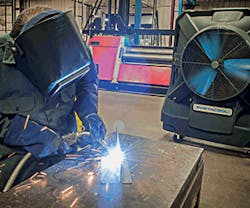Most people think of heat stroke and heat exhaustion as illnesses that affect outdoor laborers more than indoor workers. However, factory, warehouse and industrial employees are as susceptible to the ravages of high temperatures as outdoor workers.
In a confined space, for example, especially with heat-generating equipment and appliances, employees quickly can become exhausted and overheated.
Workers wearing personal protective equipment are at an even higher risk for heat-related issues, given that protective equipment such as protective clothing or respirators can trap heat next to the body.
As a manager or owner of a business that conducts work in a non-air-conditioned setting or at an open and difficult-to-cool workspace, it is important to assess the risks of a heat-related illness or injury. Heat impacts workers and work management, running the gamut from health concerns to productivity.
Heat-Related Illness Is a Killer
Working in a hot environment can be more than uncomfortable, it can be a dangerous health risk. Assistant Secretary of Labor Dr. David Michaels often emphasizes the dangers of hot working conditions, noting that each year, thousands of people become sick from heat-related illnesses. In 2014, his office reported that at least 30 U.S. workers died from heat exposure.
It is important to understand how the body handles heat and hot conditions when evaluating the potential for employee heat-related illnesses. As temperatures rise, the body releases heat more slowly. As humidity increases, sweat evaporation decreases and stagnant air makes sweat evaporation even more difficult. When these three factors are combined, you have a higher potential for health and safety concerns.
In addition, the chances for accidents due to sweaty hands, dizziness and decreased mental alertness go up considerably. Increased body temperature and discomfort also can lead to irritability and frustration that could contribute to more careless behavior. This puts the worker, his or her coworkers and the work environment at risk when temperatures rise.
Heat Impacts Productivity
Not only can high temperature environments increase the likelihood of injury or illness, they can contribute to a slower work pace. Studies show that worker productivity will decrease by more than 1 percent for every two degrees that temperatures rise over 77°F. At temperatures of 92°F or higher, there is a 16.6 percent decrease in productivity.
Heat-intense environments are not just physically uncomfortable – they can be costly to a company's bottom-line. High temperatures can increase the likelihood of injury or illness, which results in higher legal and insurance costs. OSHA offers a tool on its web site that estimates just how much an accident can cost in terms of impacting profitability: https://www.osha.gov/dcsp/smallbusiness/safetypays/estimator.html.
Using the tool, if you select "Heat Prostration" as the injury type and use their 3 percent default profit margin, you will find that just one heat-related incident can have a direct cost of more than $23,000 with indirect costs doubling that amount.
The impact of heat on workers not only reduces efficiency; it can place companies in liability situations if management reasonably could have foreseen the effects of the high temperatures. OSHA requires employers provide a safe working space – and that also means limiting the exposure of employees to high temperatures and increasing the frequency of breaks in a cool environment.
Preventing Heat Stress
There are measures employers can take to avoid heat-related injuries.
Make sure to have plenty of fluids on hand. Workers need plenty of water throughout the day (approximately every 15 minutes) in hot conditions and shouldn't wait until they feel thirsty.
Schedule rest breaks to help workers recover. OSHA advises workers to rest in the shade or in air-conditioning when possible to help cool down. Utilize or add cooling stations on worksites when possible with tools such as a portable evaporative cooler that work on a standard 110-V electricity supply.
Stay aware of conditions with your phone or tablet, especially if working outdoors. Working in full sunlight can increase heat index values by 15°F. OSHA has an app on its web site to help calculate the heat index for the worksite and helps to identify the risk level. (https://www.osha.gov/SLTC/heatillness/index.html)
Be sure workers are informed by reviewing the heat illness signs and symptoms. Training in this area is worthwhile.
Use a buddy system. Encourage workers to monitor each other for signs and symptoms of heat-related illness.
According to OSHA, basic heat safety measures need to take place around 90°F, with increased heat precautions used for temperatures at graduated intervals from there. In addition to providing hydration and scheduling breaks, securing effective, affordable cooling solutions ahead of time is the best strategy for employers. Consider various cooling options when air-conditioning is impractical or cost-prohibitive.
Oscillating and ceiling fans offer the primary benefit of creating air movement, but there are drawbacks. While an industrial oscillating fan is portable, it may not be powerful enough to cover a large, open area effectively. Conversely, ceiling fans offer no portability and installation can be costly in an industrial environment.
In some environments, one solution to lower ambient temperatures down to an acceptable level is a portable evaporative cooler. Evaporative coolers are designed to create a noticeable difference by lowering temperatures by as much as 30°F. These cooling products utilize the natural power of evaporation with high-quality evaporative media to provide maximum cooling efficiency.
Strategic placement for cooling options is key. For example, a good location for cooling options would at a line on the factory/warehouse floor that especially is hot due to its proximity to heat-generating machinery. Overall, ensuring cooler working conditions will help reduce the threat of heat-related illnesses, increase worker effectiveness and reduce the likelihood of workplace accidents.
Wise employers are proactive and take steps early, before heat-related injuries occur, to guard against heat-stress.
Mike O'Brien is vice president, manufacturing, at Portacool LLC, where he oversees all plant operations at the company. With 26 years of experience, he is well versed in work environment challenges and is an advocate for proactive planning to reduce workplace risks. O'Brien can be reached at [email protected].

